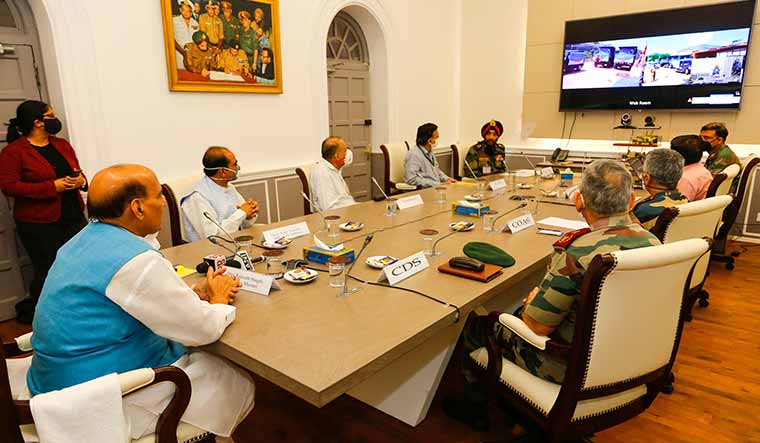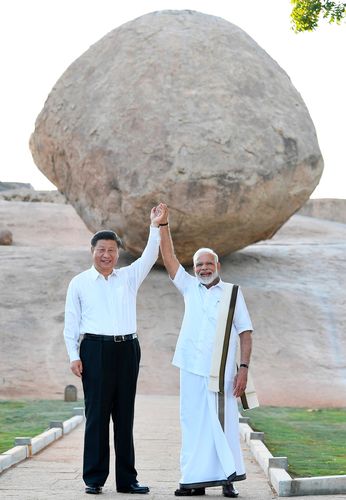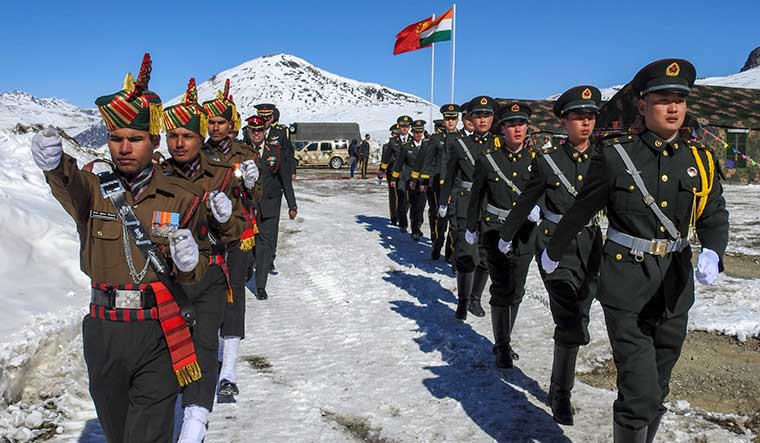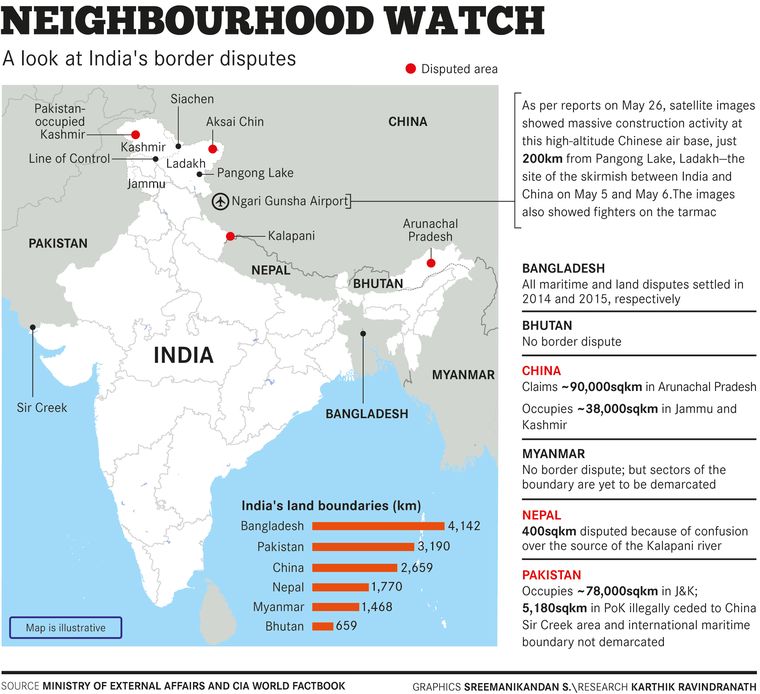Arguably, no one serving in the Indian Army knows Ladakh and China better than Lieutenant General Yogesh Kumar Joshi. He served in Ladakh during the Kargil war, was military attache in Beijing, was on the China desk at the directorate-general of military operations in the Army headquarters and now heads the Northern Command. So when he told his chief, General M.M. Naravane, on May 22 that the Chinese incursion in eastern Ladakh was an act of aggression, that was that.
Joshi had three arguments to differentiate the current intrusion from routine transgressions that take place on the 4,057-km Line of Actual Control. First, the number of Chinese troops in the area was much larger than a patrol party. Second, patrols are usually not aggressive; these men were. Third, the Chinese did not respond to local Indian commanders’ call for a ceremonial border meeting on May 1 to mark Labour Day.
On May 5, patrolmen from both countries clashed in the Pangong Lake area. A Chinese military helicopter came close to the area and the Indian Air Force responded by scrambling a Sukhoi-30 fighter. Soon, intrusions were reported from Demchok and Galwan valley in the Ladakh sector and Naku La in Sikkim.
Satellite images have shown 800 to 1,000 military tents set up by the Chinese in at least three locations on the banks of the River Galwan, which was a flashpoint in the 1962 Sino-Indian war. There are 4,000 to 5,000 Chinese troops around Galwan, Pangong Lake and Demchok in the Ladakh sector and in the Harsil area of Uttarakhand. The Indian Army, too, has moved in strength, and the troops have been told that they are in for the long haul.
Patrolling intrusions are common from May to September, when snow is not a major concern. “This is the patrolling season for troops in this area and when patrols happen, the chances of a face-off increase,” says Lieutenant General (retd) S.L. Narasimhan, a member of the National Security Advisory Board (NSAB), who had commanded a corps in the eastern sector. He says the latest standoff is marked by the presence of a higher number of Chinese troops, the increased aggression shown by the Chinese and the use of the Galwan valley as a “new front for confrontation”.
The immediate provocation, Indian officers believe, is the renewed construction by India in Daulat Beg Oldi and the Pangong Lake area. “Road construction in areas where there are differences of alignment on the LAC triggers crises. The other reason is patrolling,” says former northern Army commander Lieutenant General (retd) D.S. Hooda. “Because of different perceptions of the LAC, both sides patrol up to their perception and it leads to a problem. Like in Pangong Tso, patrolling was blocked and it led to tension.”
Usually, patrolling intrusions are sorted out quickly, but it did not happen this time. The standoff at Point 14 has been continuing for more than three weeks, with China openly asking for the removal of the Col Chewang Rinchen bridge on the Shyok river. Colonel Chewang Rinchen Setu was inaugurated by Defence Minister Rajnath Singh in October. “They are objecting now, because they were not patrolling then,” says an officer. Strategically located on the 255km road between Leh and the Karakoram pass, it is 4.5m wide and can take vehicles weighing up to 70 tonnes. Most importantly, it cuts travel time between Leh and the pass by half.
On May 7, scuffle broke out between Indian and Chinese soldiers in which approximately 10 Indians, including two officers, got injured. At Point 15, there was no clash, but Indian troops spotted the presence of Chinese personnel and some tents. Tactically, the Indian side is at a disadvantage. The Chinese have fairly good roads and they can quickly reinforce their formations from their camp in Samzungling.
There have been certain protocols between the two armies regarding patrolling. Both freely patrol the LAC in most places, including the disputed areas, but take care not to stay or leave infrastructure.
Such was the case in the Pangong Lake area, too. Here, the northern bank protrudes like a palm, and the various locations are identified as fingers to demarcate territory. While India insists that the LAC extends till Finger 8, the Chinese say that it extends only till Finger 4, making the area between Finger 4 and Finger 8 disputed. Earlier, troops from both sides used to patrol the disputed territory. Now the Chinese are not letting Indian troops patrol beyond Finger 6.
The Chinese seem to be indicating that they have come to stay this time. They are bringing fabricated tents, heavy construction equipment and are building bunkers. Perhaps for the first time since 1962, there has been movement of armoured vehicles near the Galwan valley.
India, too, is determined to stay. The Army has moved 10,000 to 12,000 troops of the Leh-based 3rd Infantry Division forward, mostly as a preventive measure. All the same, “the effort is to resolve issues through local military level talks,’’ says a defence ministry official. “The ball is in China’s court to de-escalate. If they choose not to, then we are ready for a long face-off.”
Many senior officers, however, believe that the Chinese are not making a tactical threat, but a strategic one. A great game is being played out between India and China under a “new normal’’ created by New Delhi. India made a territorial reassertion in the Himalayan belt with the abrogation of Article 370 and the creation of the twin Union territories of Jammu and Kashmir and Ladakh last year. It was followed by New Delhi releasing a new political map showing its boundary stretching from Pakistan-occupied Kashmir and Gilgit-Baltistan to Aksai Chin (which is under Chinese occupation) up to Kalapani and beyond.
China responded by uploading a new map on Sky Map, its official authority on digital maps, showing parts of Arunachal Pradesh as Chinese territory. On April 29, the World Health Organization, which was accused by US President Donald Trump of being a Chinese puppet, published a map that showed parts of Ladakh and Jammu and Kashmir as Chinese territory.
As former ambassador P. Stobdan says, the removal of Article 370 and the bifurcation of Jammu and Kashmir have changed the geopolitical dynamics of the region. India’s renewed claim over Gilgit-Baltistan and PoK has raised concern in China about the diminished negotiating power it would have with Pakistan and other neighbours. “It is now China’s turn to try and create a new normal by pushing the LAC using Ladakh as the latest flashpoint,” says Stobdan.
The area is strategically vital, and is not just a piece of land for tactical military manoeuvres. In 1962, the Chinese advance was halted at Chip Chap Valley-Depsang Plains-Daulat Beg Oldi- Karakoram pass area by a combination of the Indian Army’s death-defying resistance, the Chinese army running out of steam at this point of operational extremity and the approaching winter, says Lieutenant General (retd) Gautam Banerjee in his book China’s Great Leap Forward-II. “This left in India’s possession a strategically vital territorial wedge between Aksai Chin and the Shaksgam valley…. Subsequently, as India reiterated her sovereignty over the Siachen glacier located on the western flank of this wedge, China-Pakistan’s capacity for uninterrupted terrain domination over this region was contained to much extent,” says the book.
In other words, the Indian wedge between Aksai Chin and the Shaksgam valley is what is preventing a military and territorial link up between China and Pakistan. This wedge did not matter much earlier when India, Pakistan and China were simply holding on to what they controlled. But India altered the status quo in 1984 by capturing Siachen. It has done so again by altering the status of Jammu and Kashmir and Ladakh. China, too, is no longer satisfied with the status quo, which is hampering its Belt and Road Initiative. Chinese President Xi Jinping now seeks to get this wedge removed by capturing the land north of Pangong Lake, or at least the Galwan valley, and linking Aksai Chin with Karakoram and Gilgit-Baltistan. It guarantees China land access to Pakistan and denies India access to Afghanistan and Central Asia. “Gilgit-Baltistan also has vast freshwater reserves and is home to many of the glaciers which provide water to the Indus River System,” says Tilak Devasher, a member of the NSAB. “It also enables China to link Xinjiang with Tibet. Of late, it is the entry point of the China-Pakistan Economic Corridor, BRI’s flagship project. Without Gilgit-Baltistan, China will not have access to the Arabian Sea.’’
Author, historian and China watcher Claude Arpi says the action in Ladakh should not be seen in isolation from China’s other military-diplomatic adventures. “Beijing’s aggression is equally visible in the South China Sea, where it has continued to push its military objectives despite the Covid-19 pandemic,’’ says Arpi. “In April, a Chinese vessel allegedly sank a Vietnamese fishing boat, leading to a diplomatic spat. The Philippines joined Vietnam in denouncing the incident. Later, China declared two archipelagos in the South China Sea as its administrative districts, which Vietnam termed as a violation of its sovereignty.”
Such moves have made New Delhi suspicious that China is behind Nepal’s newfound aggression vis-a-vis India. Nepal reacted sharply when Rajnath Singh inaugurated a new road from Dharchula to Lipulekh near the Chinese border, opening a new route for the Kailash-Mansarovar pilgrimage. After the 1962 war, India has found high strategic value in posts in Lipulekh, which allow it to monitor the mountain passes to Tibet. “China is aware of it and it was at China’s behest that Kathmandu released a map showing the disputed Kalapani area, including Lipulekh, as Nepalese territory,” says an Army officer. Avinash Godbole, Chinese expert at O.P. Jindal Global University, says, “It is clear that China has taken advantage of the strained India-Nepal relations.” India-Nepal relations have nosedived after K.P. Sharma Oli took charge in 2015 as prime minister. India’s decision to stop the supply of oil and other essential commodities to Nepal, too, played a part. Nepal had blamed India for the subsequent humanitarian crisis.
China is wooing Nepal with huge investments. “Nepal has started work on the Dharchula-Tinkar road project which will help border trade with China. India must keep a watch over it.’’ says Godbole. “China has also been busy in buying off various businesses in Nepal, including a few of its media houses which now collaborate with Chinese media and reprint their material. That may be influencing domestic politics in Nepal. Moreover, China is now a major source of development funds.”
Vijay Kant Karna, executive director of the Centre for Social Inclusion and Federalism in Kathmandu, however, says New Delhi chose a very wrong time to inaugurate the road via the Lipulekh pass. “The K.P. Oli government has been under intense pressure for its mishandling of the Covid crisis, economic losses and preferential treatment to China. The government has been treating China as a colonial monarch. When Xi visited Nepal last October, Oli lined up tenders and projects. Even the hiring of Chinese language teachers in schools was offered to Beijing on a platter.” And when the Oli government faced a domestic political crisis, the Chinese ambassador to Nepal is learnt to have defused it by speaking to former prime ministers Madhav Nepal and Prachanda.
Now the big question is how long will the stalemate continue? The Depsang standoff of 2013 lasted five weeks, which ended after both sides decided to revert to their previous positions. The Chinese removed their tents and went away. But it may not happen this time. There could either be a showdown or the Chinese could be sending just a signal to India and the world rather than aiming for real aggression on the border, according to Srikanth Kondapalli, professor of Chinese studies at Jawaharlal Nehru University. In the latter case, “the face-off could last till September”, when snowfall begins.
Also read
India is taking care not to seek big power intervention. The US, which is keen to corner China on issues ranging from the Covid pandemic to the crisis in the South China sea, is ready to play a part. Trump tweeted that he was ready to mediate. Outgoing US principal deputy assistant secretary of state Alice Wells, meanwhile, offers a word of caution, saying China’s aggression is no longer rhetorical. “Whether it is on the South China Sea or whether it is along the border with India, we continue to see provocations and disturbing behaviour by China that raises questions about how it seeks to use its growing power,” she says.
Wells spoke about like-minded nations coming together to reinforce the principles of the post-World War II order. M.V. Rappai, a senior analyst with the Institute of Chinese studies, however, warned against going too far with Americans. “India decided to side with the US against China at the WHO, but it did not work,” he says. “We must know that there is a quid pro quo in such matters. China is investing in startups in India, its telecom major Huawei entered the 5G trials, so we should do a cost-benefit analysis before we take a decision to use military power or demonstrate a tilt towards America.”
New Delhi is following the road of caution, leaving the matter in the hands of its generals and ambassadors. Moreover, India has its own trump cards, like the Dalai Lama. China has always been worried that devotees of the Dalai Lama on the Nepal-Tibet border may become a springboard for creating unrest in Tibet. “Beijing has always leaned on Kathmandu to curb activities of Tibetan expatriates, whether it is celebrating the Dalai Lama’s birthday or other events related to the Tibetan struggle,” says Amitabh Mathur, former adviser to the home ministry on Tibetan matters. India could also create trouble for Pakistan with renewed focus on the situation in Gilgit-Baltistan. Pakistan’s poor handling of the Covid-19 outbreak in Gilgit-Baltistan has embarrassed Islamabad. “It has taken the locals of Gilgit-Baltistan more than six decades to find out that they are not Pakistani citizens,” says Senge H. Sering, who heads the Institute for Gilgit-Baltistan Studies in Washington, DC. “They want Pakistan to treat Gilgit-Baltistan like Pakistan-occupied Kashmir, with its own constitution, president, prime minister and separate flag. India could launch a campaign over these issues, embarrassing Pakistan, which is controlling the territory, and China, which wants to build its Belt and Road project through the territory.”








